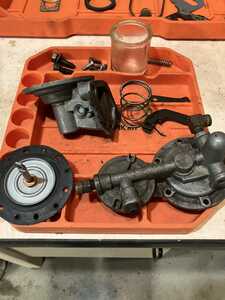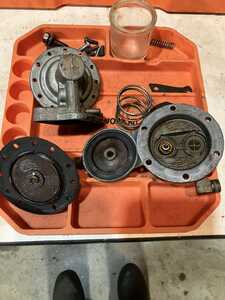Good morning,
I need some help identifying a fuel pump that was on my 1929 engine. I bought a rebuild kit for it but it is not a 29 pump.
I believe it to be a later model. A 31 to 34 pump. Please see the pics. Marked “Made in USA on the outside and FP 739 on the inside. Can anyone tell me what kit to buy Jim Carter has one that looks right and the filling station has one for a 1934 that looks right as well
Thanks
Rich
@stovebolt-6 Rich, The 1949 Master Parts Catalog says 1929-1933 is all the same pump. I could be that your pump is an aftermarket pump and uses different parts than those in a genuine Chevy pump.
Mike
Many Miles of Happy Motoring
3469 Posts on Old VCCA Chat
@35mike Mike that is entirely possible. One of the 31 engines I have has the same pump. I also looked at the kit for the 34 and it looks like this pump. The big difference is the diaphragm. The 29 the rod bolts to the diaphragm. The one I have, that looks like the 34, has a slimmer slotted rod that is riveted on the diaphragm.
I have 4 fuel pumps here and I can’t make one good one with parts I have. I had an old pump from the 53 that worked and might fit but I can’t find it.
I will search for a rebuild kit for the one on the motor. It must have worked at some point.
Thanks
@35mike I found a 6 volt electric fuel pump for a 29 on eBay. Looks like is just a inline pump. I would have to rig a filter and a way to power it. Do you know anything about these. Do they work on these engines?
I don't remember when the fuel pump diaphragm and rod changed from bolted together to riveted. I am thinking it was 1934? You can use the early kit by grinding off the crimp to remove the diaphragm, drilling and tapping the rod for a small screw and washer to secure the new diaphragm. I have done that several times and added a drop of red Loctite to secure the screw. Be sure to align the holes before "loctiting" it in place.
How sweet the roar of a Chevy four
Participant on Chatter since 11/22/2001
19758 posts on the former Chatter site
Guys, I found the pump on my 31 motor was the stock one. After cleaning it up, I rebuilt it and it works like as charm on the bench. I just put it back on the car. I put my new ignition switch in and rechecked my oil pump for flow to the top. I hope I can do some dialing in.
I still need to swap out the water pump and I will get the carb rebuilt. I don't want to do the carb myself as it looks like someone already tried and failed. I was able to replace the needle valve and the accelerator pump boot so at least I don't have gas leaking all over the floor.
Chip…. Did I hear you do carb work?? If you do, what do you charge? I have several I can offer for rebuild. You can keep the spares if you want, I only need one.
I have rebuilt 1200+ carburetors over the past 20 years and until I find someone else to take my place plan to keep going. I charge $125 plus parts and shipping. I suggest you have one for the car and a spare. Today's gasoline can gunk up one fairly quickly so a spare is good insurance. Even I have to exchange a carburetor occasionally so I can decontaminate one.
How sweet the roar of a Chevy four
Participant on Chatter since 11/22/2001
19758 posts on the former Chatter site
@stovebolt-6 Chip does a nice job. I'll bet he can put your spares to good use. Congrats on the fuel pump.
Mike
Many Miles of Happy Motoring
3469 Posts on Old VCCA Chat
Quick question on the fuel pump. I used a brake siphon to get the fuel to the pump. Can I siphon through the pump to the carb without damaging anything. I don’t want to kill my battery just getting fuel to the carb.
It's fairly common to put an electric priming pump in-line between the tank and stock pump to get fuel to the carburetor and connect it using a momentary switch. When the car sits and the fuel evaporates out of the bowl, activate the momentary switch for a few seconds to refill the bowl before starting. I've seen people use a diaphragm type pump as a priming pump but I don't like the resistance they create that the mechanical pump has to overcome. IMHO, a rotary vane pump would be a better choice. Also pay attention to the fuel pressure the electric pump provides. These old cars are low pressure. I don't have the exact pressure off the top of my head but I believe it's ~4 psi. I've read on the ACCA site that many folks there use 12v pumps on 6v to keep the pressure output low enough.
7046 old site posts
Save a life, adopt a senior shelter pet
There are many good people. If you can't find one, be one.
1938 Master Business Coupe
1953 210 Sedan
@tiny but can I pull fuel through the pump with the siphon just for a start up so I don’t have to crank the engine for a long time to get the gas to the carb.
thanks for the advice on the auxiliary pump. I may do that in the future as the car will definitely sit all winter in Maine.
I expect that what you are calling a siphon is actually a vacuum source that uses lower than atmospheric pressure to cause fuel flow from the tank. Or more accurately the lowered pressure causes atmospheric pressure to force gasoline from the tank to flow toward the carburetor. Siphons use the difference in height to push liquids from a higher source up and over an height to a lower level. Most Chevrolet carburetors are mounted above the fuel level in the gas tank.
How sweet the roar of a Chevy four
Participant on Chatter since 11/22/2001
19758 posts on the former Chatter site




